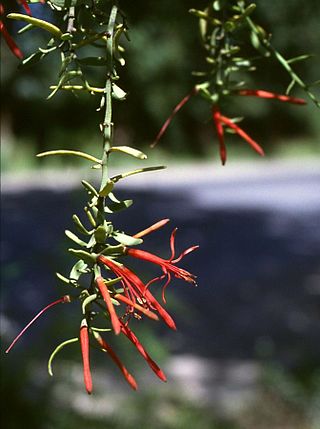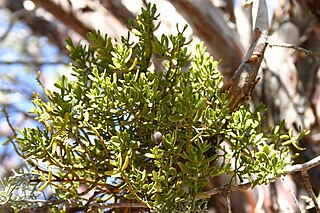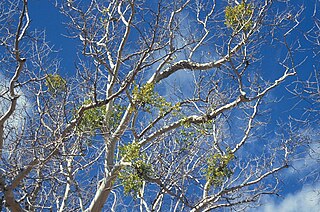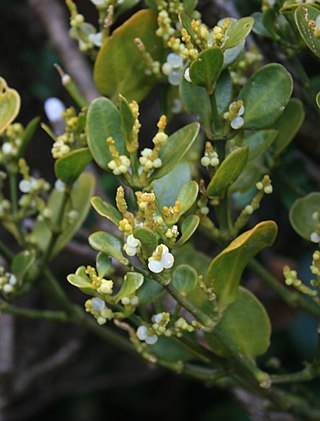
Mistletoe is the common name for obligate hemiparasitic plants in the order Santalales. They are attached to their host tree or shrub by a structure called the haustorium, through which they extract water and nutrients from the host plant.

Loranthaceae, commonly known as the showy mistletoes, is a family of flowering plants. It consists of about 75 genera and 1,000 species of woody plants, many of them hemiparasites. The three terrestrial species are Nuytsia floribunda, Atkinsonia ligustrina, and Gaiadendron punctatum Loranthaceae are primarily xylem parasites, but their haustoria may sometimes tap the phloem, while Tristerix aphyllus is almost holoparasitic. For a more complete description of the Australian Loranthaceae, see Flora of Australia online., for the Malesian Loranthaceae see Flora of Malesia.

Silene latifolia subsp. alba, the white campion is a dioecious flowering plant in the family Caryophyllaceae, native to most of Europe, Western Asia and Northern Africa. It is a herbaceous annual, occasionally biennial or a short-lived perennial plant, growing to between 40–80 centimetres tall. It is also known in the US as bladder campion but should not be confused with Silene vulgaris, which is more generally called bladder campion.

Viscum album is a species of mistletoe in the family Santalaceae, commonly known as European mistletoe, common mistletoe or simply as mistletoe. It is native to Europe and western and southern Asia.

Phoradendron is a genus of mistletoe, native to warm temperate and tropical regions of the Americas. The center of diversity is the Amazon rainforest. Phoradendron is the largest genus of mistletoe in the Americas, and possibly the largest genus of mistletoes in the world. Traditionally, the genus has been placed in the family Viscaceae, but recent genetic research acknowledged by the Angiosperm Phylogeny Group shows this family to be correctly placed within a larger circumscription of the sandalwood family, Santalaceae.

Allolepis is a genus of North American plants in the grass family.

Phoradendron californicum, the desert mistletoe or mesquite mistletoe, is a hemiparasitic plant native to southern California, Nevada, Arizona, Sonora, Sinaloa and Baja California. It can be found in the Mojave and Sonoran Deserts at elevations of up to 1400 m.

Phoradendron densum Trel. is a species of flowering plant in the sandalwood family known by the common name dense mistletoe. It is native to the western United States and northwestern Mexico, where it grows in various types of woodland habitat. It has been reported from California, Oregon, Arizona and Baja California. This mistletoe parasitizes species of cypress, including Arizona cypress, and juniper.

Phoradendron juniperinum is a species of flowering plant in the sandalwood family known by the common name juniper mistletoe. It is native to the southwestern United States and northern Mexico, where it grows in various types of woodland habitat. It has been reported from California, Nevada, Arizona, New Mexico, Oregon, Utah, Texas, Chihuahua and Sonora.

Phoradendron macrophyllum is a species of flowering plant in the sandalwood family known by the common names Colorado Desert mistletoe, bigleaf mistletoe, and Christmas mistletoe. It is native to western United States and northern Mexico from Oregon to Colorado to Texas to Baja California, where it grows in many types of wooded habitat at elevations up to 1700 m.

Phoradendron pauciflorum is a species of flowering plant in the sandalwood family known by the common name fir mistletoe. It is native to coniferous forests in California, Arizona, and Baja California.

Phoradendron villosum is a species of flowering plant in the sandalwood family known by the common names Pacific mistletoe and oak mistletoe. It is native to western North America from Oregon south into Mexico, where it grows in oak woodland and similar habitat.

Allocasuarina portuensis, commonly known as the Nielsen Park she-oak, is an extremely rare plant growing in Sydney, Australia. Encountered as a shrub or small slender tree, up to 5 metres tall, it has green drooping branchlets up to 27 cm (10.5 in) in length. It is dioecious, that is, male and female flowers are borne on separate plants. Measuring 1.2–1.5 cm (0.47–0.59 in) long and 0.8–1 cm wide, the cones are perched on 0.2–1.5 cm long peduncles arising from the branchlets.
Phoradendron capitellatum, the downy mistletoe or hairy mistletoe, is a hemiparasitic plant native to Arizona, New Mexico, Chihuahua and Sonora. It grows mostly on junipers at elevations of 800–1,700 m (2,600–5,600 ft). It is distinguished by having short, densely puberulent leaves usually less than 3 cm long. Flowers are also pubescent. Berries are pink to white, about 3 mm in diam.
Phoradendron coryae, Cory's mistletoe or oak mistletoe, is a hemiparasitic plant native to the southwestern United States and northern Mexico. It is reported from Arizona, New Mexico, Texas, Chihuahua, Coahuila and Sonora.
Job Kuijt, is a Canadian botanist, with particular interest in Viscaceae, Loranthaceae and Eremolepidaceae. He is professor at the University of Victoria on Vancouver Island of British Columbia. He was awarded a Guggenheim fellowship in 1964.
Psittacanthus biternatus is a species of mistletoe in the family Loranthaceae, which is native to Brazil, Venezuela, and Colombia.

Daniel Lee Nickrent is an American botanist, working in plant evolutionary biology, including the subdisciplines of genomics, phylogenetics, systematics, population genetics, and taxonomy. A major focus has been parasitic flowering plants, particularly of the sandalwood order (Santalales). His interest in photographic documentation and photographic databases has led to several photographic databases including Parasitic Plant Connection, Phytoimages, Plant Checklist for the Rocky Mountain National Park, and Plant Checklist for the Crab Orchard National Wildlife Refuge.

Dendrophthora, the tree destroyers, is a genus of flowering plants in the sandalwood family Santalaceae, native to tropical and subtropical Latin America and the Caribbean. They are hemiparasitic mistletoes that grow on a wide variety of host plants.
Psittacanthus gigas is a mistletoe native to Colombia. It was discovered in 1984 by Alwyn Gentry. It is most noteworthy for producing the largest leaves of any dicot shrub, with a blade or lamina up to 3.9 feet (120 cm) in length and 12 inches (30 cm) wide.













